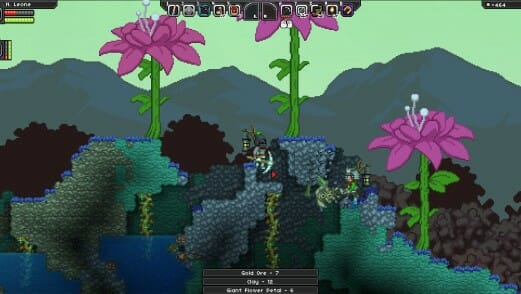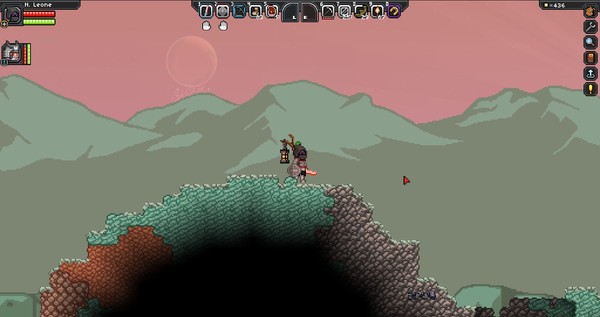Starbound Early Access (PC/Mac/Linux)

Starbound is currently available through Steam’s Early Access program. That means the game is still in active development. It’s a beta test that you can pay to take part in. This isn’t a review of the final product, but one writer’s thoughts after playing several hours of the game in beta.
For years, all my favorite games were halves of themselves. They all came from the same catalogue: a PC parts wholesaler, whose monthly circular had a few backpages dedicated to flipping game floppies for pennies on the price of shipping. That, at ten, was the price I could match, so a few times a year I’d receive a package with a handful of selections, each chosen by name alone: Cosmo’s Cosmic Adventure; Commander Keen; Crystal Caves. I’d attack them with the focus and ferocity only summonable by a pre-teen drunk on summer, and eventually I’d hit the same screen: “SHAREWARE VERSION COMPLETED! BUY THE FULL VERSION FOR MORE LEVELS!”
This splash screen was a common sight then, in the early 90s, because shareware—the practice of bundling a game’s engine with its first set of levels and distributing it for free1 —was an elegant way to get your game in front of new customers. Before the widespread adoption of the internet, this was a problem large enough to sculpt the direction of games marketing in the industry. There were far fewer ways to be introduced to a game you’d never heard about; a 200-word review in the back page of a computing magazine, next to a blurry black and white screenshot, might have been the best a small games company could have hoped for.
Shareware allowed companies to not only put a feature-complete demo directly into the hands of potential fans—recall that computing trade shows used to be a big thing—but also made ad-hoc product advocates out of anyone who wound up enjoying it. “Copy this diskette!” games companies pleaded. “Share it with your friends!” And they did, too, since shareware versions often felt like complete, if small, high-quality games. (The canonical example here being shareware DOOM.) It was, while it lasted, a brilliant symbiosis between developer and consumer that helped bolster the production of videogames, even the small or niche.
![]()
You no longer see shareware used as a sales model for games, not outside of very small or personal projects, and for a good reason: Discovery is no longer the biggest problem a studio faces. This, I think, is the core difference between 1993 and 2013: It can still be hard to get your game known, but with the advent of the internet and the simultaneous rising cost of game development, it is now much harder to pay for its construction in the first place. I’d like stronger numbers on this (and please, comment on the piece if you have sources for them!), but this old GameSpot piece on Trilobyte pegs the price of an early-90s cartridge-based game at $200,000, and Erik Bethke’s Game Development and Production puts the figure at between $1 and 3 million by 2000; Grand Theft Auto V, now not even a current-gen game, cost $266 million. Not that every new game need chase these ever-rising figures, but where goes the industry at large, so goes the publishing money. A cartridge-sized game may still cost $200,000, but you’re probably going to have to find that money yourself. Developers need, in other words, a new shareware.
Happily, they already have one. Open your Steam client right now, and you’ll see that videogames are now sortable not only by platform and genre, but also by funding model. Starbound, a PC game by the ten-employee Chucklefish Studios, employs one of these2: It is an early-access beta, a model popularized by the inescapably-popular Minecraft. Developers sell consumers access to their playable, but unfinished, games, and in exchange for mid-development funding and free QA feedback, the developers open lines of communication back to those players: now that you’ve seen how far we’ve gotten, where do you think we should go?
The resultant game is therefore, ostensibly, better for having had that feedback. Much as shareware’s distribution model gifted its games an ad-hoc disk-trading street team, the early-access beta’s funding methodology creates a devoted community around a game before that game even nears completion. When it works, it can feel haiku-grade elegant.
This model is still predicated on discovery, however, and so these proto-games demand review and discussion. It is important to be fair, though; many of these betas state plainly, “THIS IS NOT A FINISHED GAME.” There are enough games in the marketplace which are released before they’re ready; it is unfair to an open beta to hold it to the standards of a gold master. Rather than ask is this game fun, therefore, I think we really have to ask: Is this a game yet?
Any snapshot of a game under development must necessarily be incomplete; the experience you’re having may be entirely transitional. An example: I tried out Double Fine’s alpha-access space sim Spacebase DF-9 to compare it with Starbound, and managed to reach the end of the game’s content in about 90 unhurried minutes. A review of the experience is almost beside the point, even though that 90 minutes was enjoyable; it is a playable concept more than it is a strategy game, and can’t hope to compare on playability alone to completed, polished titles. The experience of being part of the DF-9 community is doubtlessly what its satisfied early adopters are buying into at present3, and what gameplay review could accurately represent the experience of discussing your own personal ideas with the game’s own developers?
Given this rubric, then, here is how Starbound fares: It is definitely a game. It is already, in fact, a terrific game.
